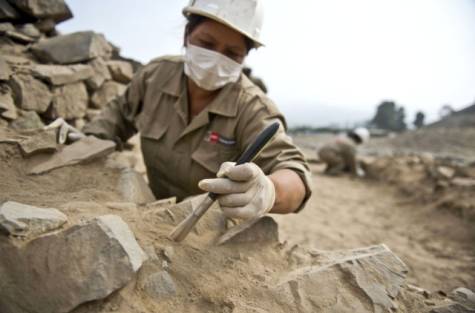The recent discovery of a ceremonial fireplace believed to be more than 5,000 years old sheds light on one of the oldest populated sites in the Americas.
The fireplace, dubbed the Temple of Fire, was discovered within the El Paraiso archeological complex in the Chillon valley, located just outside the bustling Peruvian capital.
Archaeologists say the site is comparable in age to Caral, the oldest pre-Columbian site in the Americas that was inhabited between 2,600 and 2,100 BC. Caral is located some 200 kilometres to the north and is a UNESCO World Heritage Site.
The fireplace was found when archaeologists discovered a narrow entrance on a wing of El Paraiso’s central pyramid in January, when they were removing sand and stones.
“We realised the importance of this discovery,” said Marco Guillen, the head archaeologist at the site.
The entrance, measuring some 48 centimetres wide, leads to a chamber measuring 8 metres by 6 metres where shellfish, grains, flowers and fruit were burned as offerings.
The stone walls inside “were covered with a fine coating of yellow soil, with traces of red paint”, Guillen said. ‘The smoke allowed the priests to connect with the gods.”
The temple has four levels, “each one older than the other”, Guillen said.
The find shows that the Andean world more closely connected than previously thought — this early construction set a construction blueprint reproduced in the ancient mountain chain civilisations for the centuries to come.
The central pyramid is the only building uncovered in El Paraiso. Experts say there are ten “architectural units” at the site that include temples, plazas and residences.
Archaeologists believe that the central pyramid had a communal use, while two other structures — which at a glance look like sandy hills — include buildings that appear to be homes.
“We know little about the other units, because they have not yet been studied,” said Luis Caceres, head of archeology at the Ministry of Culture.
El Paraiso is spread across 50 hectares about two kilometres from the Pacific Ocean.
At the centre of the site are stone platforms discovered by French archaeologist Frederic Engel in 1965. Today parts of the archeological zone has been taken over by farmers and urban squatters, though locals have banded together to stop further encroachment.
Evidence uncovered by Engel lead experts to estimate that some 3,000 people could have lived in El Pariso, Guillen said. Experts are now analysing waste samples to find out what they ate.
Archaeologists believe the ancient coastal civilisations raised crops including cotton, which they traded with coastal fishermen for food.
The discovery “demonstrates the importance of Lima from time immemorial”, long before the arrival of Spanish conquistador Francisco Pizarro, who founded the Peruvian capital in 1535, Deputy Culture Minister Rafael Varon told reporters when the discovery was announced on Tuesday.
“There is a lot to discover in order to untangle the mysteries held at El Pariso,” Guillen said. “We need to know if below these structures there are even older ones.”
“We just began and already found the Temple of Fire,” he said.
